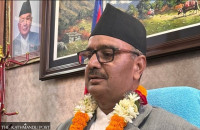National
Nepal hopes to resolve Kalapani dispute through a meeting of the foreign secretaries
Nepal has made a formal request for a meeting of an existing foreign secretary-level mechanism that was mandated specifically to settle border disputes.
Anil Giri
In the wake of an uproar caused by the release of a new political map by India, Nepal hopes to iron out border differences through a foreign secretary-level meeting.
As pressure mounts on the KP Sharma Oli administration to address India’s inclusion of Kalapani, which Nepal claims as its own, within Indian borders, the Ministry of Foreign Affairs has requested India’s Ministry of External Affairs to schedule a meeting of the foreign secretaries to initiate talks.
Read: India’s new political map places disputed territory of Kalapani inside its own borders
“We have already opened up diplomatic channels with India,” Foreign Minister Pradeep Gyawali told the Post. “We have sent a request to activate the foreign secretary-level mechanism to resolve the boundary dispute that surfaced recently.”
Although India has not confirmed the meeting, the Nepali side said it was hoping for a positive response soon.
According to Nepali diplomats in New Delhi, both sides are expected to finalise a date for the meeting once Bangladesh President Md Abdul Hamid concludes his visit to Kathmandu. Hamid is arriving in Kathmandu on Tuesday on a four-day visit.
Meanwhile, Nepali Ambassador to India Nilamber Acharya and Indian Foreign Secretary Vijaya Gokhale on Thursday touched upon the issue during a regular meeting in New Delhi and discussed convening the foreign secretary-level meeting.
“Gokhale was positive about holding the meeting at the earliest date possible,” an official at the Nepali Embassy in Delhi told the Post on condition of anonymity.
Days after the Post reported that India's new political map had included disputed territories within its own borders, Oli convened an all-party meeting on Saturday where parties from across the spectrum arrived at a conclusion that Kalapani, Lipu Lekh and Limpiyadhura are inalienable parts of Nepali territory and that the government must employ diplomatic channels and existing mechanisms to hash out a resolution.
The foreign ministries of both countries have both commented publicly on the issue. On Wednesday, Nepal's Ministry of Foreign Affairs said that outstanding border-related issues between the two countries should be resolved mutually and that the Nepal government won’t accept any unilateral decisions.
“Nepal is clear about Kalapani being part of Nepali territory,” Nepal’s statement read.
A day later, New Delhi said that the new Indian political map “accurately depicts the sovereign territory of India”.
“The new map has in no manner revised our boundary with Nepal. The boundary delineation exercise with Nepal is ongoing under the existing mechanism,” Raveesh Kumar, spokesperson for India’s Ministry of External Affairs, told a regular press briefing in New Delhi.
The existing mechanism the foreign ministries of both countries were referring to is a foreign secretary-level mechanism that has been mandated to resolve boundary disputes in Kalapani and Susta, with the technical support of the Boundary Working Group at the Surveyor General level. The third meeting of the Nepal-India Joint Commission at Foreign Minister level in 2014 decided to form the mechanism. However, as of the last joint commission meeting in Kathmandu in August, no progress has been made yet.
Suresh Raj Neupane contributed reporting from New Delhi.




 15.12°C Kathmandu
15.12°C Kathmandu















